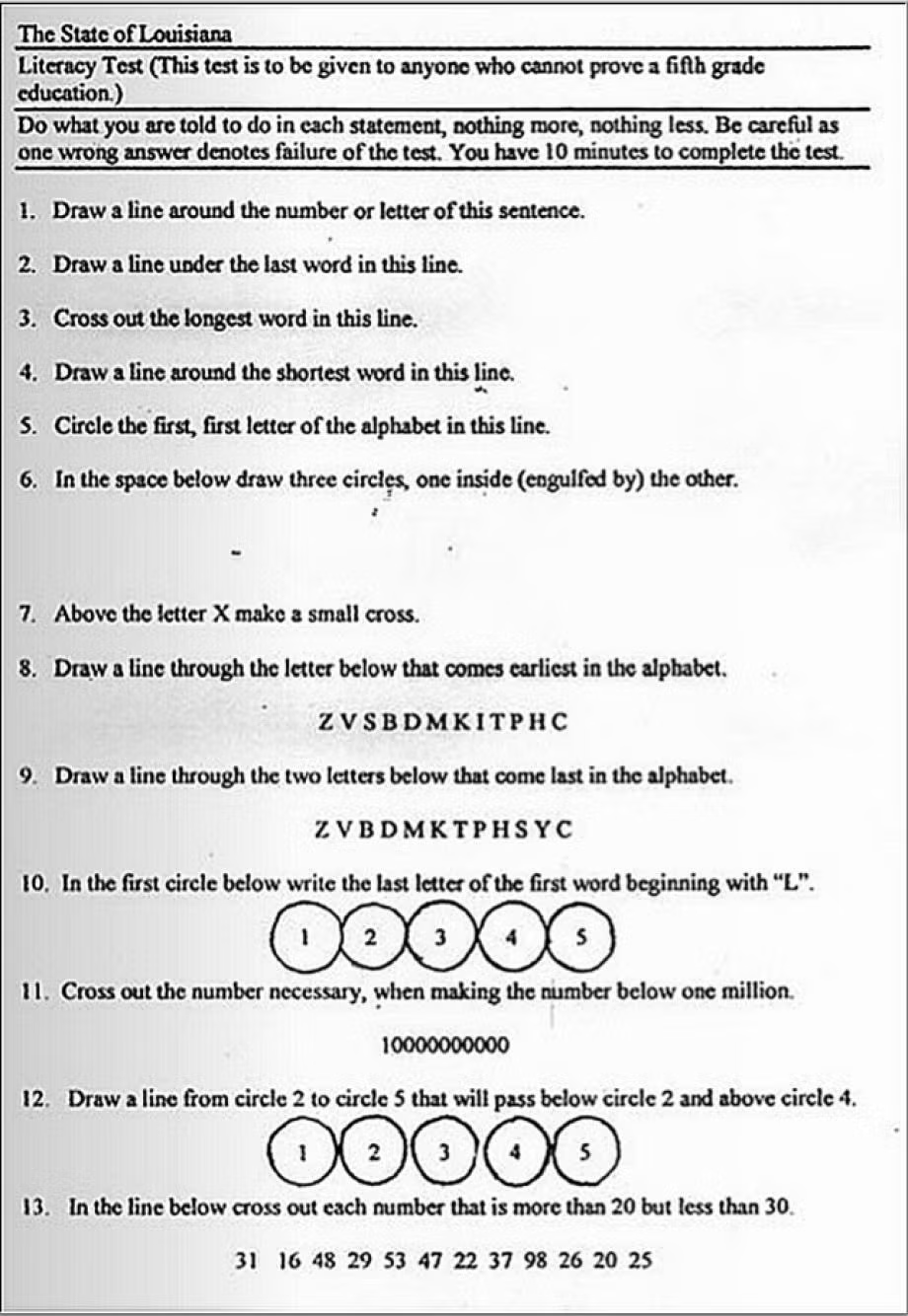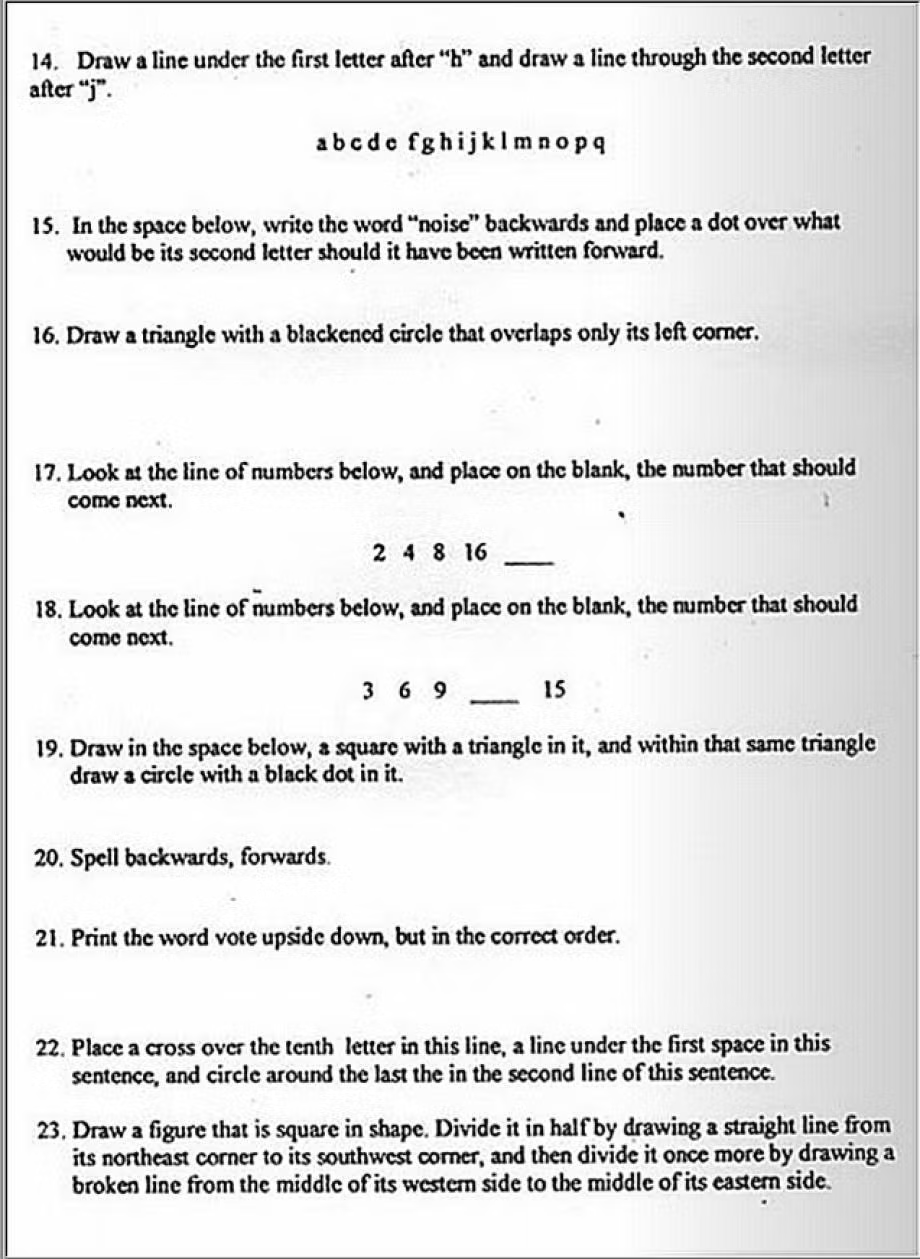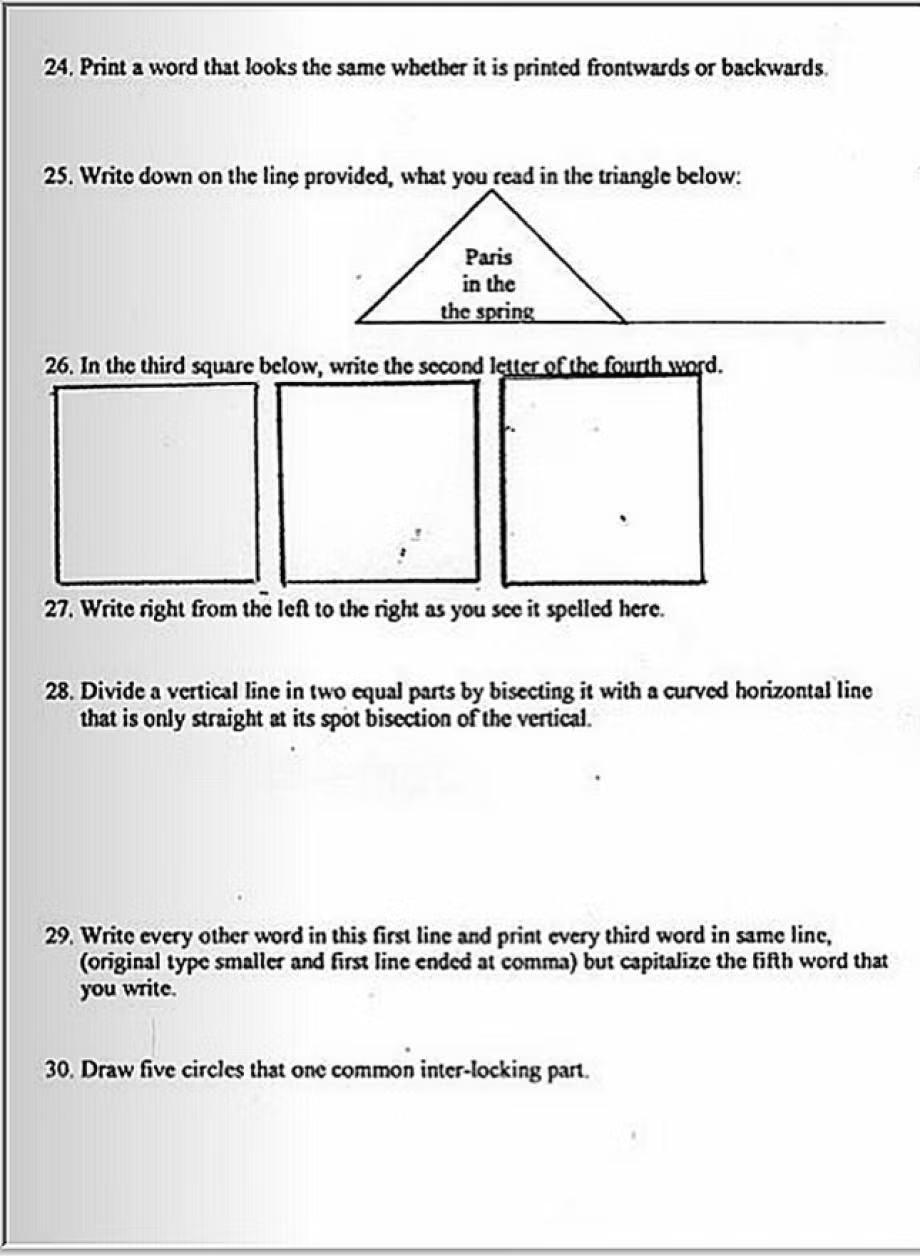
In William Faulkner’s 1938 novel The Unvanquished, the implacable Colonel Sartoris takes drastic action to stop the election of a black Republican candidate to office after the Civil War, destroying the ballots of black voters and shooting two Northern carpetbaggers. While such dramatic means of voter suppression occurred often enough in the Reconstruction South, tactics of electoral exclusion refined over time, such that by the mid-twentieth century the Jim Crow South relied largely on nearly impossible-to-pass literacy tests to impede free and fair elections.
These tests, writes Rebecca Onion at Slate, were “supposedly applicable to both white and black prospective voters who couldn’t prove a certain level of education” (typically up to the fifth grade). Yet they were “in actuality disproportionately administered to black voters.”
Additionally, many of the tests were rigged so that registrars could give potential voters an easy or a difficult version, and could score them differently as well. For example, the Veterans of the Civil Rights Movement describes a test administered in Alabama that is so entirely subjective that it measures the registrar’s shrewdness and cunning more than anything else.

The test here from Louisiana consists of questions so ambiguous that no one, whatever their level of education, can divine a “right” or “wrong” answer to most of them. And yet, as the instructions state, “one wrong answer denotes failure of the test,” an impossible standard for even a legitimate exam. Even worse, voters had only ten minutes to complete the three-page, 30-question document. The Louisiana test dates from 1964, the year before the passage of the Voting Rights Act, which effectively put an end to these blatantly discriminatory practices.
Learn more about the history of Jim Crow voter suppression at Rebecca Onion’s original post here and an update here. And here you can watch video of Harvard students trying to take the test.

Note: Note: An earlier version of this post appeared on our site in 2014.
Related Content:
Philosopher Richard Rorty Chillingly Predicts the Results of the 2016 Election … Back in 1998
Josh Jones is a writer and musician based in Durham, NC. Follow him at @jdmagness


If you cannot pass this test you should not be allowed to vote.
This is of very little use without the scoring guide — several of the descriptions are ambiguous, and we do not know which were accepted as correct. Each of the instructions is relatively simple to reach *a* reasonable interpretation of, which allows a casual reader to come to the conclusion that this test was actually quite easy.
This is a very different test if ambiguous instructions accept only one potential interpretation as valid, or accept satisfying either potential interpretation. I would also propose “requires noticing that ambiguity and satisfying all possible interpretations” but that violates “Do what you are told … nothing more.” and the general lemma that there should be a 1 to 1 correspondence between tasks and instructions.
E.g.:
“Write every other word in this first line and print every third word in the same line, (original type smaller and first line ended at comma) but capitalize the fifth word that you write”
Does every third word mean “write word first print word same” or “other this and third the”?
Are both answers acceptable? Only one?
Does “but capitalize the fifth word that you write” apply to the whole instruction, or only the second clause?
And “Spell backwards, forwards”
The comma introduces ambiguity. It could either be telling you that the the following word modifies the previous clause (and you should spell the word “backwards” in a forward manner) in which case the comma is unnecessary and the sentence has the same exact meaning without it, *or* it could be telling you that the word order of the sentence is unusual (like “Use the force, you must”), in which case the comma is necessary.
As a result, both “backwards” and “sdrawrof” are completely correct performances of the task.
Does the answer key instruct the examiner to accept only “backwards,” only “sdrawrof,” *either* answer?
Several instructions, as-written, *are* impossible to follow exactly:
For instance “draw a line around the shortest word in this line” is likely asking you to circle the “a”, but, by the exact definition of a “line”, this is impossible, as a line cannot contain any curves or angles, but a shape cannot be “around” something else without having curves or angles.
And, most egregiously, “Draw three circles, one inside (engulfed by) the other” is self-contradictory. This is logically equivalent to the instruction: “Draw three circles: the engulfed, and the engulfer, with the engulfed completely contained by the engulfer.” The number of circles is specified to be three, but the specification of their arrangement does not allow for the existence of a third.
Is it safe to assume that the test-writer was inexact with directions and that lackadaisical performance of instructions will be accepted?
Be careful, as one wrong denotes failure of the test.
Ack. That last line should be “Be careful, as one wrong answer denotes failure of the test.” My mouse pointer got away from me as I was re-editing my phrasing.
CAUTION, I found this on crmvet dot org:
[NOTE: At one time we also displayed a “brain-twister” type literacy test with questions like “Spell backwards, forwards” that may (or may not) have been used during the summer of 1964 in Tangipahoa Parish (and possibly elsewhere) in Louisiana. We removed it because we could not corroborate its authenticity, and in any case it was not representative of the Louisiana tests in broad use during the 1950s and ’60s.]
Do the test then, and I’ll tell you how you’ve failed.
The ambiguity is not a bug but a feature so that failure is guaranteed.
Although I was aware of that, and trying to draw attention to it, I somehow failed to consider that the scoring might be entirely left to the tester’s discretion…
And, according to the Veterans of the Civil Rights Movement web archive page on Voting Rights in Louisiana, it does appear to be the case that, although the authenticity of this particular test cannot be corroborated, the scoring of all such eligibility tests was left entirely to the discretion of each locality’s Registrar of Voters. And while their *literacy* exams were overall reasonable (aside from the inherent language barrier if not made available in all languages), the true bar was that applicants were required to be “of good character” to be eligible to vote, and this determination, too, was entirely at the discretion of the local voting registrar.
First comment: obvious bait.
Second comment: hook, line, and sinker.
Arguing with people on the internet is almost never a good use of your time, folks.